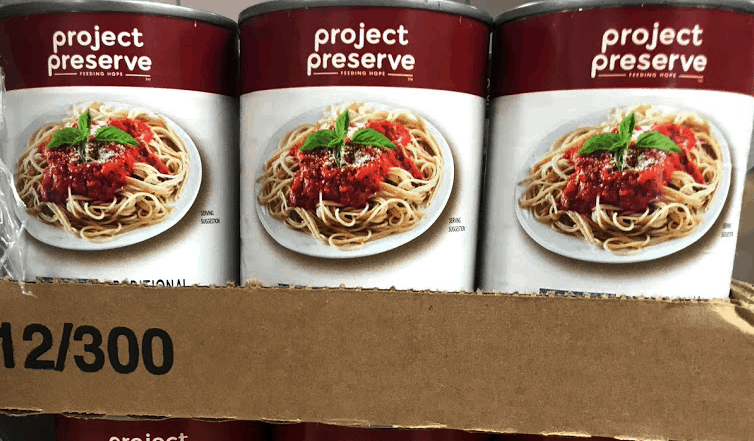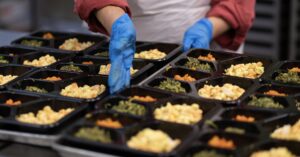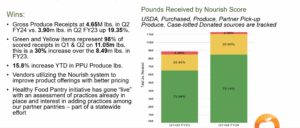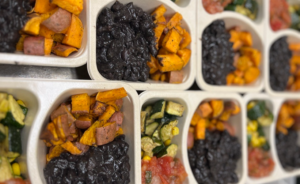Food banks are starting to throw around their purchasing power.
Because of pressure from food banks, some food manufacturers are starting to remove added salt, sugar and fats from their canned and other goods. A side benefit is that more nutritious food is also ending up on the shelves of grocery retailers, highlighting the ability of food banks to use their purchasing clout to create a healthier food system.
Food banks’ movement toward more nutritious food accelerated during Covid, when the sector benefited from billions of dollars of government assistance to purchase fresh produce. When the government funding went away, food banks continued to emphasize healthy food, given the upside for improved public health.
Now it’s hard to find a food bank that does not prioritize distributing nutritious food, even if it means moving away from a long-standing reliance on donated food (not always the healthiest) and putting dollars toward purchasing. With substantial amounts going toward purchasing, food banks are finding their voice. “This is a customer group that has specific needs that can be met,” said Collin Tuthill, CEO of Royal Food Import Corp. “Why would we not give them what they want?”

Food banks know exactly what they want, thanks to nutrition guidelines developed in 2020 by Healthy Eating Research, a unit of the Robert Wood Johnson Foundation. Designed specifically for food banks, the guidelines measure foods by their levels of saturated fat, sodium and sugar, placing them into categories of green (use often), yellow (use sometimes) or red (use rarely).
With the guidelines, food banks can identify the healthfulness of individual food products, down to the milligram. Currently, at least 100 food banks are using the guidelines in some fashion, mostly to rank their food inventory.
Using the guidelines to influence food manufacturers is a newer development. Blue Ridge Area Food Bank reached this stage after employing the HER guidelines along with a system called Nourish to increase the amount of green or yellow food it distributes to 98% in the first half of last fiscal year, and decreasing the percentage of food ranked red from 4.26% to 2.06% during that time.
To further reduce the amount of red food in its inventory, the food bank knew it needed the help of its vendors. When Food Sourcing Manager Greg Knight ran into Tuthill of Royal Food at a Feeding America conference, he explained that the food bank had stopped purchasing a certain type of tuna because of excessive sodium. Royal got to work, developing new versions of the product, including one that put it into the green category. Now Royal’s tuna is back on the food bank’s shelves, and Royal has made the new low-salt version its main tuna offering for retailers as well.
Food banks were not a major part of Royal’s business until the pandemic, noted Tuthill. Now its 100 or so food bank customers make up about 25% of Royal’s business, which overall generates about $90 million a year. The sector is “a new area of growth for us,” Tuthill said. “Food banks buy exactly what we sell and we are a low-cost provider.”
While individual food banks may feel a constant struggle for funds to purchase food, the industry as a whole has significant clout. Noted Knight of Blue Ridge Area Food Bank, “The [food manufacturing] industry is starting to see food banking as something that’s going to be here. And when you look at all of us together, we’re a big customer. We do a lot of business.”
The Feeding America network purchased 1.1 billion meals in fiscal year 2023, according to its 2023 annual report. A spokesperson noted that, “Unfortunately, we don’t have a good dollar equivalent for this in our reporting.” That figure, of course, does not include food purchases made by the many food banks and pantries that operate outside the Feeding America network.*
As a food bank that sources canned food items on behalf of other food banks through its Project Preserve social enterprise, Second Harvest Food Bank of Middle Tennessee sits in the middle of food-bank buyers and food manufacturers. It purchases food in high volumes to get discounted rates, enabling it to offer very low prices to its food-bank customers.
Several of those customers have asked Project Preserve to provide HER ratings on all the items it offers, said Kim Molnar, Chief Operating Officer. At the same time, Project Preserve has been putting upward pressure on its suppliers to provide food that adheres to higher nutrition standards.
Even before HER was created, Project Preserve persuaded a supplier to develop new products, such as vegetable lasagna and chicken with rice, that were lower in sodium. Now, in response to Project Preserve’s ongoing prodding, the manufacturer is also moving to reduce the sodium content in all of its products, including canned meats such as beef stew and chili. “Almost all the canned meat items are red under HER, so we’re hoping this pushes them to yellow,” Molnar said.
Low-sodium will now be the standard version of the eight or nine products that Project Preserve purchases from this food manufacturer. Which means that the low-sodium products will also be appearing on grocery store shelves, thanks to Project Preserve’s influence. “We’re their largest customer,” Molnar noted, “and we’ve been a drumbeat on this.”
Perhaps the biggest factor facilitating healthy change in the food system is the HER guidelines, which make it possible to be very specific about the nutrients that should be present in different foods. “It’s not typical that there is uniform and concise, clear direction being given by the customer,” said Tuthill of Royal Food. “When you get that really clear direction on how you can help your customer, it makes life so much easier.” – Chris Costanzo
*This paragraph is a correction, replacing an earlier uncited estimate of $300 billion.
Like what you’re reading?
Support Food Bank News
This article was made possible by the readers who support Food Bank News, a national, editorially independent, nonprofit media organization. Food Bank News is not funded by any government agencies, nor is it part of a larger association or corporation. Your support helps ensure our continued solutions-oriented coverage of best practices in hunger relief. Thank you!
Connect with Us:















